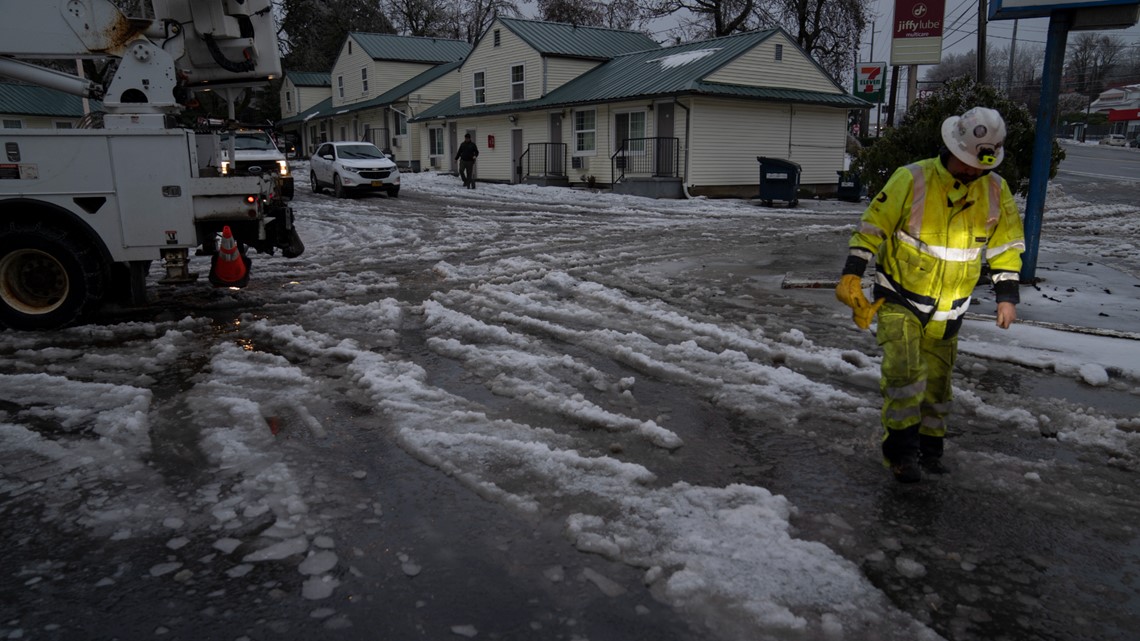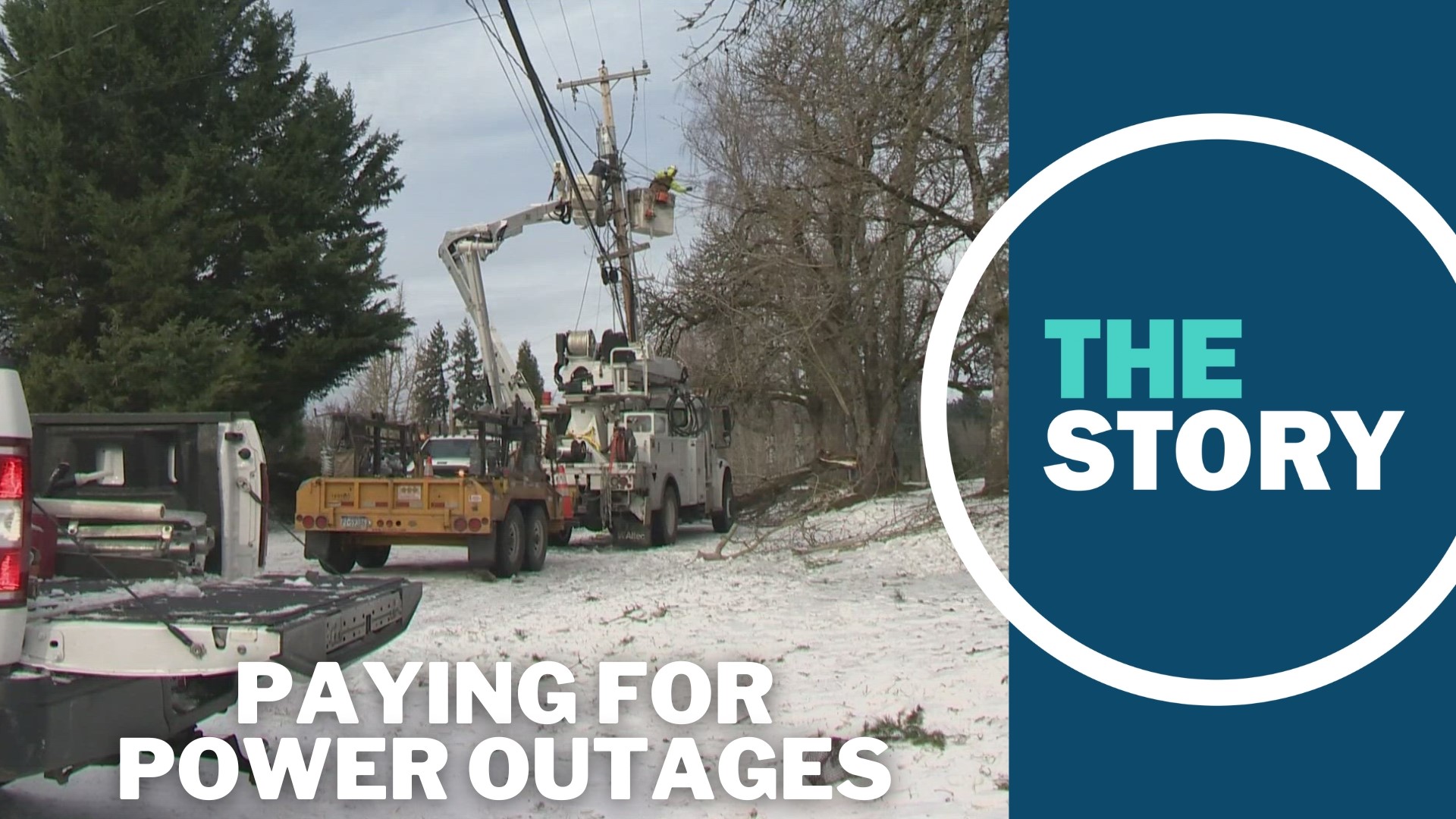SALEM, Ore. — Many Portlanders just received their first power bill after a rate hike from Portland General Electric and a week of trying to keep warm amid temperatures hovering at or below freezing. On top of that, there's a good chance they'll soon be covering the cost for the outages that left hundreds of thousands of people without power, some of them multiple times or for days on end.
According to a statement from the company, PGE had restored power to more than 524,000 customers as of Monday, repairing 23 transmission lines, restoring 69 distribution lines, repairing 14 substations, fixing 599 transformers and 348 power poles. At the peak of its winter storm response, PGE had more than 1,800 crew and support staff responding. It got help from other crews from throughout Oregon, Washington, Idaho and California.
In short, it was a massive task. But was it bigger than it had to be?
PGE is not a public utility; it's "investor-owned" — like neighboring Pacific Power, it's a for-profit corporation with a regional monopoly. When the company wants to raise rates, it has to lobby the Oregon Public Utility Commission (PUC), the state's regulatory body for utility companies, and prove that the hikes are necessary.
In 1984, Oregon voters decided that they didn't have enough of a voice at the PUC, so they passed an initiative that founded the Oregon Citizens’ Utility Board (CUB), a small nonprofit tasked with sticking up for utility customers. It's funded by a mix of individual contributions, grants, paid sponsorships of energy conferences and other events, and sometimes gets money from the PUC to work on behalf of customers.
"This is going to be our 30th anniversary," said Bob Jenks, CUB's executive director. "During that time, we've literally saved customers somewhere in the neighborhood of $9 billion by fighting unnecessary rate increases, stopping utilities from making bad investments, a whole series of things like that. So, that's really how we do the work."
But, Jenks admits, it's somewhat of a David-and-Goliath situation: CUB has a staff of 10 people, and they're charged with trying to provide oversight for all six of Oregon's investor-owned utility companies.
"I've always thought that we're an organization that sort of swings above our weight class and does make a difference," Jenks said, "and again, the end results on the amount of money that we've saved customers off their utility bills is really the success that we've had over the years."
Untangling the storm response
CUB has heard complaints from many PGE customers during the winter storm, with some criticizing the amount of time it took to get power restored in their area, a lack of communication from PGE, or outages just disappearing from the company's outage map — making it seem like power had been restored when it had not, in fact, come back.
That last issue, at least, is one that doesn't make much sense to Jenks, because PGE customers practically all have smart meters these days.
"Our understanding from PGE's automated meter system is that every meter pings back to the company every 15 minutes," Jenks said. "And if you don't have power in your house, the company should know that, and the company shouldn't be thinking that house has power restored if it doesn't because it's not getting that signal."
That automatic notification was supposed to be a major boon of smart meters over the old way of doing things. Traditionally, a customer would have to actively call and report that they'd lost power, meaning hundreds or thousands of people might be calling all at once. Even if they're calling an automated line, which PGE does still have, that's a lot of calls — and they still may not represent every single customer who has actually lost power.
"Every 15 minutes, my meter is telling PGE how much power I used in the last 15 minutes," Jenks explained. "But my meter is also telling the company in the process that it's alive, that it's working — and if they're not getting that report, that should mean that that meter is out. So how their mapping was suggesting that meters were working when they weren't, to me doesn't make sense ... and maybe that's not what happened, but that's again what we've been hearing."


Calculating the costs
CUB will be watching closely when PGE is expected to ask for yet another rate hike on top of the 17-18% that many customers are now seeing on their bills. Jenks said that the company has filed a deferral to begin tracking the storm costs, which will lead to a regulatory process at the PUC. The power company can't pass costs onto customers without getting approval first.
"Ultimately, PGE is going to ask for a bunch of money from customers to help cover the cost of the storm restoration," Jenks said. "If the storm restoration was harder and more expensive and difficult to manage because these systems didn't really communicate well, the company didn't fully understand what was happening in the field, then we can ask that the company not get full recovery for it. We can also in the process find out if there's fixes that the company needs to do in order to make this system work well."
They'll also try to find out if the crews that PGE brought in from elsewhere were necessary, if perhaps PGE should have had the resources on-hand to address the outages on their own.
The process works a little like a court case. Jenks said that CUB has the right of discovery, so they can ask questions and request documentation from PGE. They'll start by just asking PGE to clarify what happened with these customer complaints, then they'll bring any outstanding issues to the PUC.
CUB said it will look into how PGE spent customers' money during the storm, and specifically mentioned investigating the breakdown in PGE's distributed generation network, which includes larger generators at places like hospitals. That system is supposed to provide backup sources of power to the grid, but saw "significant issues" this month.
But ultimately, CUB doesn't get to make the decisions. They can argue their case with the PUC, the state's regulatory body, which decides how much PGE will get to raise its rates.
"They know us, they listen to our voice, they listen to the evidence," Jenks said. "And a lot of it will be 'What really happened?' Can we show that there was a problem that was related to this? If we can't show evidence of problems here, then obviously, we're not gonna penalize the company. But if there is stuff that that's the right call for, then I think we can look at that and ask for those kinds of things."
According to a statement from the PUC, utilities like PGE are required to file "major event reports" within 20 business days of something like this month's storm. In the report, the companies must explain what happened to the system, how they went about restoring power, and what challenges they faced.
"Once the PUC has reviewed the reports, the agency will explore lessons learned and work with the utilities to improve resilience," state regulators said. "The PUC may also request the utilities to appear before the Commission for a further discussion, but no decision has been made at this point."

